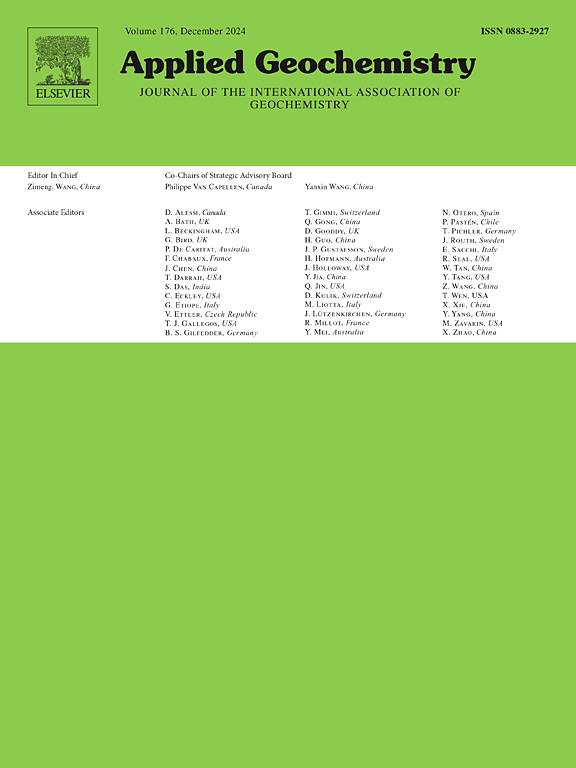一种新的1,10-菲罗啉测定草酸盐可萃取铁的方法
IF 3.1
3区 地球科学
Q1 GEOCHEMISTRY & GEOPHYSICS
引用次数: 0
摘要
不同固相铁的分离是评价沉积物中铁的环境功能的重要手段。草酸盐是一种常用的萃取剂,可以通过络合作用有效地萃取沉积物中的铁(氢)氧化物。但在分光光度法中,过量的草酸会干扰铁与1,10-菲罗啉的络合,导致铁的测量失败。在本研究中,我们发现了一种有效的草酸铁样品分光光度分析方法,通过调节pH为7-9,改变了铁-草酸配合物的结构,保证了铁与1,10-菲罗啉的络合。进一步探索发现,光解和加热也能分解草酸铁配合物,但性能不如pH调节。标准溶液吸光度(Abs)与浓度(Con)呈良好的线性关系:Abs = 0.1934 × Con + 0.1360, R2为0.9997,准确度为97.1%,相对标准偏差为1.4%,证明了该方法的可靠性。总的来说,预处理简单,调整pH后有机溶剂(草酸盐)的影响减弱。该方法有望提供一种可靠、有效、预处理少、经济、灵敏的新型检测方法,为研究铁矿物的环境功能提供帮助。本文章由计算机程序翻译,如有差异,请以英文原文为准。
A new 1,10-phenanthroline method for oxalate-extractable iron measurement
Iron separation from different solid phases is essential for evaluating the environmental function of iron in sediments. Oxalate is a commonly used extractant that effectively extract iron(hydro)oxides in sediments by complexation. However, when using spectrophotometry method, excess oxalate will interfere the complexation of iron with 1,10-phenanthroline leading to the failure of iron measurement. In this study, we discovered an effective method for spectrophotometric analysis of iron samples with oxalate by adjusting the pH to 7–9, which changes the structure of the Fe-oxalate complexes and ensured the complexation of iron with 1,10-phenanthroline. Further exploration indicates that photolysis and heating also decompose Fe-oxalate complexes, but the performance is not as good as pH adjustment. The standard solution exhibits a strong linear relationship between absorbance (Abs) and concentration (Con): Abs = 0.1934 × Con + 0.1360, with a R2 of 0.9997, accuracy of 97.1 %, and relative standard deviation of 1.4 %, which demonstrate the reliability of this method. Overall, the pretreatment is simple, and the influence of the organic solvent (oxalate) is diminished after pH adjustment. This method is expected to contribute to community by providing a new reliable, effective, less pre-treatment, economical, and sensitive testing approach and hopefully assist in the investigation on environmental function of iron minerals.
求助全文
通过发布文献求助,成功后即可免费获取论文全文。
去求助
来源期刊

Applied Geochemistry
地学-地球化学与地球物理
CiteScore
6.10
自引率
8.80%
发文量
272
审稿时长
65 days
期刊介绍:
Applied Geochemistry is an international journal devoted to publication of original research papers, rapid research communications and selected review papers in geochemistry and urban geochemistry which have some practical application to an aspect of human endeavour, such as the preservation of the environment, health, waste disposal and the search for resources. Papers on applications of inorganic, organic and isotope geochemistry and geochemical processes are therefore welcome provided they meet the main criterion. Spatial and temporal monitoring case studies are only of interest to our international readership if they present new ideas of broad application.
Topics covered include: (1) Environmental geochemistry (including natural and anthropogenic aspects, and protection and remediation strategies); (2) Hydrogeochemistry (surface and groundwater); (3) Medical (urban) geochemistry; (4) The search for energy resources (in particular unconventional oil and gas or emerging metal resources); (5) Energy exploitation (in particular geothermal energy and CCS); (6) Upgrading of energy and mineral resources where there is a direct geochemical application; and (7) Waste disposal, including nuclear waste disposal.
 求助内容:
求助内容: 应助结果提醒方式:
应助结果提醒方式:


